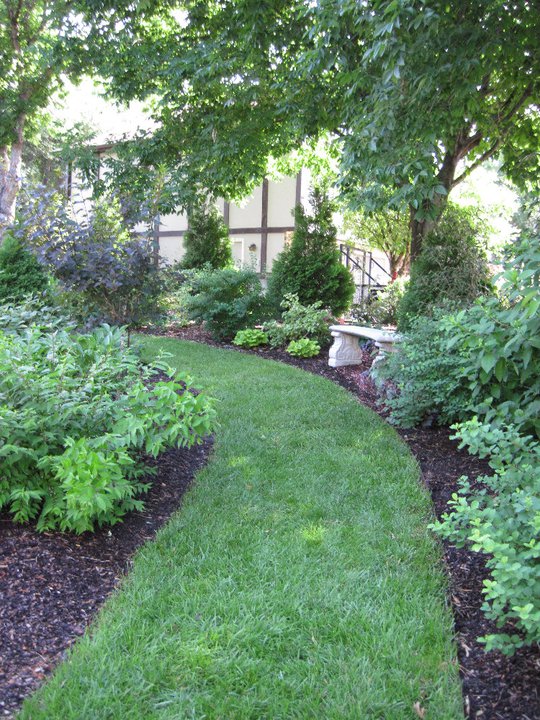My granddaughter and I were playing in the backyard the other day. One minute she was chasing me and laughing and the next she was frozen in one spot with huge tears streaming down her cheeks. I figured her brother had something to do with it (not unusual), but it turned out that I was the culprit. The path she had chosen came to an abrupt end so she couldn’t get to me from where she was and it confounded her.
It didn’t take long to solve her little dilemma and dry her tears; she was fine in an instant. I however, have been thinking about pathways ever since. Don’t be alarmed. I’m not becoming deeply philosophical here, musing like Robert Frost about which of the paths in our lives to choose. No, I’m considering how important it is to understand the functions of pathways and then how to design them to improve the landscape.
In a concrete sense. (no pun intended, but definitely appreciated!), a pathway is simply a means to get from one place to another — typically in the shortest possible distance and time. And, if the goal is to take the garbage to the trash can or to the curb for pick-up, those are reasonable expectations. But, what if the journey isn’t quite so specifically task oriented? Where can a garden path lead you then?
When thoughtfully designed and creatively implemented, pathways can add so much more than mere functionality to a space. They can entice you to explore and discover, they can spark your emotions and imagination, they can create a sense of mystery and excitement and they can compel you to slow down and observe the natural world around you. A pathway can take you on a fabulous journey through your own backyard.
Within the home landscape, there are primary, secondary and tertiary paths. Primary pathways define centers of important activity. They direct visitors to the home’s entrances, they point to dominant windows and establish sight-lines from which to view the property. Most importantly however, they begin to reveal the story of the house and the personalities of the people who live there. Is the walkway designed and landscaped in a style that reflects formality and symmetry communicating a degree of reserve, or is it a looser and more relaxed style, suggesting an open casualness?
Secondary paths are the walkways that add mystery, suspense and surprise to the landscape. They meander through the landscape, only giving hints of what’s ahead. Perhaps they lead to private benches, hidden waterfalls or luscious perennial gardens.
Rosemary Verey, an English writer and gardener celebrated the idea of including wandering paths when she wrote, “Your garden must never reveal itself at a single glance; you should be able to walk around it experiencing constant feelings of surprise, anticipation and changing mood.”
Tertiary paths are purely functional ones, like those that take us to our garbage cans, our grills or our sheds. Since they are part of routine, daily life, they tend to be shorter, direct routes from Point A to Point B; they are focused on convenience rather than aesthetics. Human nature being what it is, we often create our own tertiary paths when they don’t exist where we want them.
Regardless of the size of the yard and the purpose of the path, the combination of creative design with the right materials is the key to creating successful pathways. Well-planned pathways help to make small yards seem larger and make large yards seem more intimate. They not only create transitions between areas, they also link them together and help build unity in the design.
The shape of a path contributes to the mood it conveys. A gentle serpentine line, or one that has an S-shaped curve, is considered the “line of beauty.” Its organic shape is calming and strolling down a serpentine path promotes curiosity as you wonder what is around the next bend. Periodically planting taller plants to intentionally hide the next view from sight helps to pull wayfarers along the path.
A straight path generally communicates a functional and almost pragmatic message that the destination is directly ahead, especially if it is constructed out of a solid material like concrete. The formality of a straight path can be softened however, by allowing side plantings to lightly sweep over the edges,or interspersing the walkway with groundcovers.
A zigzag path, or one in which the path traverses at 90 degree angle is born out of the Japanese “eight bridges” or Yatsuhashi. According to Japanese cultural beliefs, evil spirits can be avoided on crooked bridges since evil spirits flow in straight lines. Because of its complexity, a zigzag path encourages a deliberate, relaxed pace that gives time to appreciate the surroundings.
The range of materials for pathways is extensive, giving multiple options for both design choices and budget. Concrete, natural stone, brick, wood, mulch and even grass are among the most popular choices for residential use.
When choosing materials, just as in designing the space, consider the style and scale of the house first. Walkways should enhance the property, not fight against it. A front walk made from mulch and stepping stones wouldn’t fit with a two-story brick colonial home in a gated community, but could work well with a log cabin in a wooded setting.
The mood you want to establish is another factor in choosing walkway materials. Stepping stones and pavers intertwined with groundcovers and other low growing or fragrant plants give a more casual feel than a precise, regular pattern of cut stone or brick. Combining materials such as flagstone set in crushed gravel or varying the shape or color of the pavers can add interest and create connections with the architecture and the environment.
The design staff at Embassy Landscape truly understands the importance of designing pathways into the landscape instead of just letting them happen. Let them enhance the beauty, excitement and mystery of your yard. Call them today; they’re ready to help.















